Conduit and Sink OFCs
Conduit OFC and Sink OFC is an empirical quantitative method of classifying corporate tax havens, offshore financial centres (OFCs) and tax havens.[1][2][3]
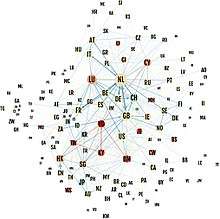
Traditional methods for identifying tax havens analyse tax and legal structures for base erosion and profit shifting (BEPS) tools. However, this approach follows a purely quantitative approach, ignoring any taxation or legal concepts, to instead follow a big data analysis of the ownership chains of 98 million global companies. The technique gives both a method of classification and a method of understanding the relative scale – but not absolute scale – of havens/OFCs.[5][6]
The results were published by the University of Amsterdam's CORPNET Group in 2017, and identified two classifications:[5][6]
- 24 global Sink OFCs: jurisdictions in which a "disproportional amount of value disappears from the economic system" (i.e. the traditional tax havens).
(See the table below for the list of the Sinks) - 5 global Conduit OFCs: jurisdictions "through which a disproportional amount of value moves toward sink OFCs" (i.e. modern corporate tax havens).
(Conduits are: Netherlands, United Kingdom, Switzerland, Singapore, and Ireland)
Our findings debunk the myth of tax havens[lower-alpha 1] as exotic far-flung islands that are difficult, if not impossible, to regulate. Many offshore financial centers[lower-alpha 1] are highly developed countries with strong regulatory environments.
— Javier Garcia-Bernardo, Jan Fichtner, Frank W. Takes & Eelke M. Heemskerk, CORPNET University of Amsterdam[4]
In 2017, the European Parliament adopted the CORPNET approach into their frameworks for addressing tax havens.[7] In 2018, research by Gabriel Zucman showed that using Orbis database connections specifically underestimates the scale of Ireland, which the Zucman–Tørsløv–Wier 2018 list showed is the largest Conduit OFC in the world.[8][9][10] This aside, CORPNET's Conduits and Sinks, reconcile closely with the most noted academic top ten tax haven lists.
Background
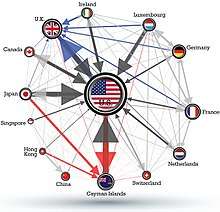
The lack of an accepted definition for identifying tax havens (and even offshore financial centres), results in different lists, including:
- Academic leaders in tax haven research:[11] Hines (1994, 2007, 2010)[12][13][14] Dharmapala (2008, 2009),[15] and Zucman (2015, 2018).[16][10][9]
- OECD lists: Started with 35 locations in 2000 (none of which were OECD members),[17] but by 2017, only listed Trinidad & Tobago as a tax haven.[18]
- IMF OFC lists: Started with 46 OFCs in June 2000 using qualitative methods;[19] refined to 22 OFCs in April 2007 using purely quantitive methods;[20] listed the 8 major OFCs in 2018 who handle 85% of all flows;[21] by 2010, the tax academics considered OFCs as synonymous with tax havens.[22]
- Oxfam lists: Focus on legal corporate tax avoidance, and ranked OECD members Netherlands, Ireland and Luxembourg in their top 10.[23][24]
- ITEP lists: Focus on offshore structures of US S&P500 firms, and list the Netherlands, Ireland, the Caribbean, and Luxembourg in their top 5.[25]
There are "traditional" tax havens common on all these lists (e.g. some Caribbean and Channel Islands locations), which some global regulators have either blacklisted, or have issued formal warnings/threat of sanctions against, unless transparency is increased.[26][27]
However, a key difference between the lists regards the major OECD and EU tax havens (or offshore financial centres), such as Switzerland, Ireland the Netherlands and Luxembourg (amongst others).[28] Major regulators like the EU and the OECD don't regard OECD or EU countries as tax havens, and point to their transparency and compliance with international regulations.[29][30][31][32]
Academic leaders in tax haven research, and other non–governmental organizations, point to the role of OECD and EU tax havens in tax avoidance from base erosion and profit shifting (BEPS) schemes, like the Double Irish, the Single Malt and the Dutch Sandwich.[33][34][35][36] They regard them as major tax havens in their definitions of tax havens.[9][10]
CORPNET Report
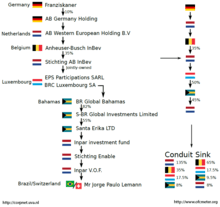
A report published in Nature in 2017 on the analysis of offshore financial centres called: "Uncovering Offshore Financial Centers: Conduits and Sinks in the Global Corporate Ownership Network",[4] provided a quantitative and scientific approach to the classification of tax havens.[37][38][1][3]
The report was the result of a multi-year investigation by political economists and computer scientists in the CORPNET research group at the University of Amsterdam. CORPNET is a European Research Council funded group at the University of Amsterdam investigating networks of corporate control.[2][39]
The report used the Moody's Orbis corporate database,[40] to examine 98 million global companies and their 71 million ownership connections (using big data computer modelling) to identify 5 global Conduit OFCs (Netherlands, United Kingdom, Ireland, Singapore and Switzerland). These are countries of high financial reputation (i.e. not formally labelled "tax havens" by OECD/EU), but who have "advanced" legal and tax structuring vehicles (and SPVs) that help legally route funds to the 24 tax havens (called Sink OFCs), without incurring tax in the Conduit OFC (or even tax in the source of funds location, where royalty payment schemes can be used).[4][41][5]
The work built on methods established in the "Offshore–Intensity Ratio",[42] and in particular the understanding "activity" relative to the "scale" of the domestic economy in a country.[43] At its crudest level, the Offshore-Intensity Ratio explains why the countries at the top of global GDP per capita lists are mostly tax havens.
The EU Parliament's Policy Department on Economic and Scientific Policies included the research in its findings for the EU Committee on Money laundering, tax avoidance and tax evasion (PANA),[44] and by tabulating against existing EU–IMF–FSI list of tax havens, showed material gaps in EU understanding of conduits.[7]
CORPNET's top 5 Conduits and top 5 Sinks are 9 of the 10 largest tax havens identified in 2010 by one of the academic founders of tax haven research, James R. Hines Jr.. Hines' 2010 list of 10 major tax havens only differs in its omission of the U.K., which in 2010, had only just reformed its corporate tax system.[12] CORPNET's top 5 Conduits and top 5 Sinks closely reconcile with the top 10 major corporate tax havens of other major academic and non–governmental organisation tax haven lists. Other tax academics have incorporated the research into their understanding of tax havens.[45]
Conduit OFC
.png)
Conduit OFCs are described as having advanced legal and tax systems designed to enable corporations to route funds from high tax locations (e.g. Germany) to the Sink OFCs (e.g. Bermuda). They tend to have attractive "holding company" regimes (e.g. no withholding taxes, foreign dividends exempt from taxes, capital gains reliefs, full double–tax relief), advanced tax treatment of intellectual property regimes, and large global networks of bilateral tax treaties.[4][47][48]
For example, CORPNET's five major Conduit OFCs, all have a top–ten ranking in the 2018 Global Innovation Property Centre (GIPC) IP Index.[46][49] IP has been described as the "raw materials of corporate tax avoidance",[50] and "the leading corporate tax avoidance vehicle".[51][52]
Conduit OFCs are shown to be dominated by major law firms and global accounting firms, who create the lawfully constructed special purpose vehicles (SPVs) and BEPS tools that make the connections with the Sink OFCs, by exploiting legislative loopholes such as the Double Irish and Dutch Sandwich. They advise clients on anticipating future changes (e.g. from OECD BEPS processes), that may need new loopholes (e.g. the Single malt arrangement).[53][4]
Other researchers into tax havens have written that professional service firms in the major OECD and EU tax havens write most of their State's relevant taxation and SPV-related legislation, so that they can create and protect loopholes, and refer to such jurisdictions as being a "captured" by their financial services industry.[54][55][56] The legal and tax structuring undertaken by Conduit OFCs is considered beyond the trust–structuring type work of the traditional tax haven "offshore magic circle" law firms. Conduit OFCs need structures that can integrate with bilateral tax treaties involving G20 countries, as well as meeting U.S. GAAP / SEC Regulations that U.S. multinationals, one of the largest users of Conduit OFCs, need to adhere to.[57][58][59]
CORPNET's top 5 global Conduit OFCs channel 47% of corporate offshore connections and include the following:[4][60]



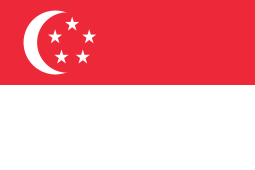

Sink OFC
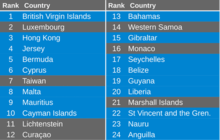
Sink OFCs cover a broad range of locations from very small countries (e.g. the Marshall Islands), to major global financial centres (e.g. Hong Kong).[4]
Just because funds reach a Sink OFC, does not mean that they remain dormant. Quite the contrary, the funds can be invested in assets all over the world, but their legal ownership and future gains remain in the Sink OFC. For example, the circa US$1 trillion of US company offshore cash is held in Sink OFCs (esp. the Caribbean).[67][68]
The report highlighted some interesting aspects of the 24 Sink OFCs:[4]
- British Virgin Islands – in terms of connections, the BVI was the "Netherlands of Sink OFCs" and heavily linked with the Conduit OFC United Kingdom.
- Luxembourg and Hong Kong – could have been considered Conduit OFCs, but CORPNET's research showed they are even bigger Sink OFCs (e.g. long-term homes for funds), Luxembourg (for routing funds from high-tax EU countries), and Hong Kong (for routing funds out of China).
- Jersey – remains a unique link with major Conduit OFC, Switzerland (because the study could not capture individual "Jersey trusts", it noted that the scale of Jersey could still be understated).
- Bermuda, British Virgin Islands, Cayman Triad – these three traditional tax havens are heavily interlinked and starting to present as one large Sink OFC.
- Taiwan – has been a controversial entrant on several tax haven lists (the Tax Justice Network calls Taiwan the "Switzerland of Asia",[69] however, Taiwan is not on any EU/OECD/IMF tax-haven list), and is identified as the 2nd largest Asian Sink OFC.
- Cayman Islands – the Cayman Islands are becoming the biggest financial centre for Central and Latin America.[70]
- Malta – the report highlights the rise of Sink OFC Malta as an emerging tax haven "inside" the EU,[71][72] which has been a source of wider media scrutiny.[73]
- Mauritius – has become a major Sink OFC for both SE Asia (especially India), and African economies, and now ranking 8th overall.[74]
OECD failings
Feargal O'Rourke CEO PwC (Ireland)
Cited "architect" of the Double Irish BEPS tool[75][76]
Irish Times, 2015[77]
CORPNET highlighted the lack of progress the OECD's Base erosion and profit shifting (BEPS) project was making, and that the OECD's support of transparent intellectual property–based tax structuring (or "patent boxes" and "knowledge boxes"), is incompatible with the emerging position of intellectual property as the leading BEPS tool in conduit OFCs.[78] The reasons for this failure are discussed in failure of OECD BEPS Project.
An example of an IP–based BEPS tool is Ireland's Capital Allowances for Intangible Assets (CAIA) tool, also known as the "Green Jersey", which has an effective tax rate of 0–2.5%. Apple used the CAIA (or Green Jersey) BEPS tool in Q1 2015, resulting in the "leprechaun economics" restatement of Irish GDP by 34.4 percent. Ireland has other IP–based BEPS tools (Ireland as the first OECD nexus-compliant KDB),[79] and is a supporter of the OECD BEPS project (see box).[77]
Isle of Man omitted
The Isle of Man (the "IOM") was absent from the list of top Sink OFCs. The IOM appears on tax–haven lists and ranks 42 on the 2018 Financial Secrecy Index.[80][81]
The Chief Minister of the IOM, Howard Quayle, announced that the CORPNET report proved that the IOM is not a tax haven.[82][83] However, CORPNET researchers from the University of Amsterdam directly replied to Howard Quayle's article[84] clarifying that while the IOM does not appear as a leading Sink OFC for corporate tax avoidance, it does not mean that individuals (personal bank accounts and trusts) do not use the IOM to avoid taxes, and particularly United Kingdom VAT.
Other commentators have added that the IOM is "failing as a tax haven", and is now too small to appear in major studies like the CORPNET research.[85]
Ireland underestimated
The CORPNET report used legal corporate connections on the Orbis database, rather than the actual "quantum" of money, as its primary metric of analysis. In theory, the authors felt that this does not impede the goal of classification, and of making relative rankings. However, it does mean the "monetary amount" of potential tax avoidance was not calculated.[4]
The acclaimed tax haven academic and author of The Hidden Wealth of Nations, Gabriel Zucman, used a different quantitative approach. Zucman focused on macro–data of national statistical accounts. In theory, the total assets in a system should equal the total liabilities. By aggregating national account data, Zucman identified an excess of liabilities over assets, implying that the missing assets (to balance the equation), are hidden in tax–havens. On this basis, in 2015, he estimated that 8% of the world's wealth (or US$7.6 trillion) was "missing" in offshore tax–havens.[86][87]
Zucman's analysis highlighted the special case of Ireland and why the Orbis database underestimates Ireland's scale as one of the world's largest corporate tax avoidance, or BEPS, hubs.[88] In 2018, Zucman (et alia) showed that many of Ireland's U.S. multinationals don't appear on Orbis (e.g. Facebook), or only have a small fraction of their data on Orbis (e.g. Google and Apple). Analysed using "quantum of funds" (not "Orbis connections"), Zucman showed Ireland is one of the largest corporate tax shelters in the world, and a route for Zucman's estimated loss of 20% in EU corporate tax revenues annually.[8][9][10]
See also
- Corporate tax haven
- Tax haven
- Offshore Financial Centres
- Financial Centres
- Base erosion and profit shifting
- Double Irish arrangement
Notes
- As discussed in the Definitions sections of tax havens, and of offshore financial centres, most tax academics consider the terms as being synonymous and use them inter–changeably
References
- Daniel Boffey (25 July 2017). "Netherlands and UK are biggest channels for corporate tax avoidance". The Guardian. Archived from the original on 24 May 2018. Retrieved 27 April 2019.
Almost 40% of corporate investments channelled away from authorities and into tax havens travel through the UK or the Netherlands, according to a study of the ownership structures of 98m firms.
- Hugo Millar (31 July 2017). "Is the U.K. Already the Kind of Tax Haven It Claims It Won't Be?". Bloomberg News. Archived from the original on 13 June 2018. Retrieved 27 April 2019.
The U.K. is the second biggest offshore financial centre for the 'conduit' of money to small 'sink' tax havens like the British Virgin Islands or Cayman Islands, researchers at University of Amsterdam have concluded in a report publisher in Nature.
- Mark Buchanan (11 April 2017). "Tax Havens Can Be Surprisingly Close to Home". Bloomberg View. Archived from the original on 17 June 2018. Retrieved 10 June 2018.
The U.K., the Netherlands and Switzerland play bigger roles than they might have realized.
- Javier Garcia-Bernardo; Jan Fichtner; Frank W. Takes; Eelke M. Heemskerk (24 July 2017). "Uncovering Offshore Financial Centers: Conduits and Sinks in the Global Corporate Ownership Network". Scientific Reports. 7 (6246): 6246. arXiv:1703.03016. Bibcode:2017NatSR...7.6246G. doi:10.1038/s41598-017-06322-9. PMC 5524793. PMID 28740120.
- Professor Eelke Heemskerk (7 November 2017). "These five countries are conduits for the world's biggest tax havens". The Conversation. Archived from the original on 6 July 2018. Retrieved 27 April 2019.
- "The countries which are conduits for the biggest tax havens". RTÉ.ie. RTE News. 25 September 2017. Archived from the original on 26 April 2019. Retrieved 25 April 2019.
- Professor Brigitte Unger (March 2017). "Offshore activities and money laundering: recent findings and challenges" (PDF). European Parliament. pp. 39–42. Retrieved 27 April 2019.
Section 7.1. Offshore Centers are a European problem: [..] Against the idea of OFCs as exotic Caribbean islands, the authors show that many OFCs are highly developed countries.
- Gabriel Zucman (April 2018). "The Missing Profits of Nations" (PDF). National Bureau of Economic Research, Working Papers. p. 11–15. Archived (PDF) from the original on 12 June 2018. Retrieved 27 April 2019.
Slide 11: Issues with previous literature on global profit shifting
- Mark Paul (13 June 2018). "Ireland is the world's biggest corporate 'tax haven', say academics". Irish Times. Archived from the original on 24 August 2018. Retrieved 27 April 2019.
Study claims State shelters more multinational profits than the entire Caribbean
- Richard Rubin (10 June 2018). "Zucman:Corporations Push Profits Into Corporate Tax Havens as Countries Struggle in Pursuit, Gabrial Zucman Study Says". Wall Street Journal. Archived from the original on 4 April 2019. Retrieved 27 April 2019.
The new research draws on data from countries such as Ireland, Luxembourg and the Netherlands that hadn’t previously been collected.
- "Banks in Tax Havens: First Evidence based on Country–by–Country Reporting" (PDF). EU Commission. July 2017. p. 50. Archived (PDF) from the original on 23 June 2018. Retrieved 15 August 2018.
Figure D: Tax Haven Literature Review: A Typology
- James R. Hines Jr. (2010). "Treasure Islands". Journal of Economic Perspectives. 4 (24): 103–125.
Table 1: 52 Tax Havens
- James R. Hines Jr. (2007). "Tax Havens" (PDF). University of Michigan. Archived (PDF) from the original on 24 September 2016. Retrieved 15 August 2018.
There are roughly 45 major tax havens in the world today. Examples include Andorra, Ireland, Luxembourg and Monaco in Europe, Hong Kong and Singapore in Asia, and the Cayman Islands, the Netherlands Antilles, and Panama in the Americas.
- James R. Hines Jr.; Eric M. Rice (February 1994). "FISCAL PARADISE: FOREIGN TAX HAVENS AND AMERICAN BUSINESS" (PDF). Quarterly Journal of Economics (Harvard/MIT). 9 (1). Archived from the original (PDF) on 25 August 2017. Retrieved 15 August 2018.
We identify 41 countries and regions as tax havens for the purposes of U. S. businesses. Together the seven tax havens with populations greater than one million (Hong Kong, Ireland, Liberia, Lebanon, Panama, Singapore, and Switzerland) account for 80 percent of total tax haven population and 89 percent of tax haven GDP.
- Dhammika Dharmapala; James R. Hines Jr. (2009). "Which countries become tax havens?" (PDF). Journal of Public Economics. 93 (9–10): 1058–1068. doi:10.1016/j.jpubeco.2009.07.005. Archived (PDF) from the original on 8 August 2017. Retrieved 15 August 2018.
- Gabriel Zucman; Thomas Torslov; Ludvig Wier (June 2018). "The Missing Profits of Nations". National Bureau of Economic Research, Working Papers. p. 31. Archived from the original on 2 April 2019. Retrieved 15 August 2018.
Appendix Table 2: Tax Havens
- "Towards Global Tax Co-operation" (PDF). OECD. April 2000. p. 17. Archived (PDF) from the original on 31 March 2018. Retrieved 2 April 2018.
TAX HAVENS: 1.Andorra 2.Anguilla 3.Antigua and Barbuda 4.Aruba 5.Bahamas 6.Bahrain 7.Barbados 8.Belize 9.British Virgin Islands 10.Cook Islands 11.Dominica 12.Gibraltar 13.Grenada 14.Guernsey 15.Isle of Man 16.Jersey 17.Liberia 18.Liechtenstein 19.Maldives 20.Marshall Islands 21.Monaco 22.Montserrat 23.Nauru 24.Net Antilles 25.Niue 26.Panama 27.Samoa 28.Seychelles 29.St. Lucia 30.St. Kitts & Nevis 31.St. Vincent and the Grenadines 32.Tonga 33.Turks & Caicos 34.U.S. Virgin Islands 35.Vanuatu
- Vanessa Houlder (September 2017). "Trinidad & Tobago left as the last blacklisted tax haven". Financial Times. Archived from the original on 15 December 2018. Retrieved 27 April 2019.
Alex Cobham of the Tax Justice Network said: It’s disheartening to see the OECD fall back into the old pattern of creating ‘tax haven’ blacklists on the basis of criteria that are so weak as to be near enough meaningless, and then declaring success when the list is empty.”
- "Offshore Financial Centers: IMF Background Paper". International Monetary Fund. 23 June 2000. Archived from the original on 23 August 2018. Retrieved 27 April 2019.
- Ahmed Zoromé (1 April 2007). "Concept of Offshore Financial Centers: In Search of an Operational Definition" (PDF). International Monetary Fund. Archived (PDF) from the original on 7 April 2016. Retrieved 27 April 2019.
IMF Working Paper 07/87
Cite journal requires|journal=(help) - Damgaard, Jannick; Elkjaer, Thomas; Johannesen, Niels (June 2018). "Piercing the Veil of Tax Havens". International Monetary Fund: Finance & Development Quarterly. 55 (2). Archived from the original on 12 June 2018. Retrieved 27 April 2019.
The eight major pass-through economies—the Netherlands, Luxembourg, Hong Kong SAR, the British Virgin Islands, Bermuda, the Cayman Islands, Ireland, and Singapore—host more than 85 percent of the world’s investment in special purpose entities, which are often set up for tax reasons.
- Gabriel Zucman (August 2013). "The Missing Wealth of Nations: Are Europe and The U.S. Net Debtors or Net Creditors?" (PDF). The Quarterly Journal of Economics. 128 (3): 1321–1364. CiteSeerX 10.1.1.371.3828. doi:10.1093/qje/qjt012. Archived (PDF) from the original on 9 August 2017. Retrieved 27 April 2019.
'Tax havens are low-tax jurisdictions that offer businesses and individuals opportunities for tax avoidance' (Hines, 2008). In this paper, I will use the expression 'tax haven' and 'offshore financial center' interchangeably (the list of tax havens considered by Dharmapala and Hines (2009) is identical to the list of offshore financial centers considered by the Financial Stability Forum (IMF, 2000), barring minor exceptions)
- "Tax Battles: the dangerous global race to the bottom on corporate tax". Oxfam. December 2016. Archived from the original on 17 June 2018. Retrieved 2 April 2018.
- "TAX BATTLES The dangerous global Race to the Bottom on Corporate Tax" (PDF). Oxfam. December 2016. Archived (PDF) from the original on 31 March 2018. Retrieved 2 April 2018.
- Richard Phillips; Matt Gardner; Alexandria Robins; Michelle Surka (2017). "Offshore Shell Games 2017" (PDF). Institute on Taxation and Economic Policy.
Amount of Tax Haven Connections (Figure 1, Page 11), Amount of Tax Haven Profits (Figure 4, Page 16)
- Daniel Boffey (5 December 2017). "EU blacklist names 17 tax havens and puts Caymans and Jersey on notice". The Guardian. Archived from the original on 7 April 2019. Retrieved 27 April 2019.
- Juliette Garside (2 December 2017). "From paradise to blacklist: EU's net starts to close on tax havens". The Guardian. Archived from the original on 1 May 2019. Retrieved 27 April 2019.
- Ken Silva (1 August 2017). "New study offers more nuanced look at offshore finance". Cayman Compass. Archived from the original on 2 April 2018. Retrieved 2 April 2018.
When offshore financial centers receive criticism for being “tax havens,” they often counter by pointing to larger countries in Europe and elsewhere that practice many of the same policies decried by the international community. A new study compiled by researchers at the University of Amsterdam buttresses that counter-argument, naming the U.K., Ireland, the Netherlands and other developed countries as places that facilitate tax avoidance
- Suzanne Kelly (2 October 2017). "There is a definition of a tax haven - and Ireland doesn't make that grade". Irish Independent. Archived from the original on 26 March 2018. Retrieved 2 April 2018.
- Hugh O'Connell (23 July 2013). "OECD tax chief: 'Ireland is not a tax haven'". TheJournal.ie. Archived from the original on 27 April 2018. Retrieved 27 April 2019.
- Caterina Tani (14 December 2017). "EU countries are not 'tax havens', parliament says". EUobserver. Archived from the original on 27 June 2018. Retrieved 27 April 2019.
- Jane Paters (6 December 2017). "EU RELEASES TAX HAVEN BLACKLIST; NETHERLANDS NOT ON IT". NL Times. Retrieved 27 April 2019.
- "Ireland named world's 6th worst corporate tax haven". TheJournal.ie. 12 December 2016. Archived from the original on 26 March 2018. Retrieved 2 April 2018.
- "Now Brazil puts Ireland on its tax haven blacklist". Tax Justice Network. 17 September 2016. Archived from the original on 12 June 2018. Retrieved 2 April 2018.
- "Oxfam says Ireland is a tax haven judged by EU criteria". Irish Times. 28 November 2017. Archived from the original on 24 April 2018. Retrieved 2 April 2018.
- "MANTRAS AND MYTHS: A true picture of the corporate tax system in Ireland" (PDF). RTE News. February 2017. Archived (PDF) from the original on 3 October 2017. Retrieved 7 April 2018.
- "Offshore Financial Centers and the Five Largest Value Conduits in the World". CORPNET. 24 July 2017. Archived from the original on 3 April 2018. Retrieved 2 April 2018.
- "What is an OFC Conduit and Sinks". CORPNET. 2017. Archived from the original on 25 March 2018. Retrieved 2 April 2018.
- "Sinks and Conduits: Identifying Offshore Financial Centres by using Big Data". The IFC Review. 1 March 2018. Archived from the original on 17 June 2018. Retrieved 27 April 2019.
- Alistair King (22 August 2017). "How researchers have used Orbis to uncover offshore financial centres". Moodys BUREAU VAN DIJK. Archived from the original on 27 April 2019. Retrieved 27 April 2019.
- Naomi Fowler (25 July 2017). "New research on key role major economies play in global tax avoidance". Tax Justice Network. Archived from the original on 12 June 2018. Retrieved 27 April 2019.
- Jan Fichtner (2015). "The Offshore–Intensity Ratio Identifying the Strongest Magnets for Foreign Capital" (PDF). City, University of London. SSRN 2928027. Archived (PDF) from the original on 3 October 2015. Retrieved 27 April 2019. Cite journal requires
|journal=(help) - "How Apple and Other Multinationals Avoid Taxes and Accountability: A Network Study of Offshore Finance". CORPNET. 27 September 2016. Archived from the original on 16 April 2018. Retrieved 15 April 2018.
- "PANA Committee on Money laundering, tax avoidance and tax evasion". EU Parliament. 2018. Archived from the original on 15 April 2018. Retrieved 15 April 2018.
- Aidan Regan (25 April 2019). "Ireland is a tax haven — and that's becoming controversial at home". Washington Post. Retrieved 25 April 2019.
As the recent research of Gabriel Zucman and the CORPNET research team at the University of Amsterdam shows, Ireland is a “conduit tax haven,” acting as a tax-avoiding funnel between nation-states and enabling the transfer of capital without taxation
- "U.S. Chamber International IP Index, 6th Edition, 2018" (PDF). Global Intellectual Property Center. February 2018. p. 6. Archived (PDF) from the original on 18 December 2018. Retrieved 27 April 2019.
- "These Five Countries Are Conduits For The World's Biggest Tax Havens". Huffington Post. 24 July 2017. Archived from the original on 3 April 2018. Retrieved 2 April 2018.
- Editorial (10 November 2017). "Stranger than paradise: the truth about tax". Financial Times. Archived from the original on 16 June 2018. Retrieved 27 April 2019.
- United States Chamber of Commerce (February 2018). "GIPC IP Index 2018" (PDF). p. 6. Archived (PDF) from the original on 21 May 2018. Retrieved 28 September 2018.
Figure I: U.S. Chamber International IP Index 2018, Overall Scores
- "The Corporate Tax Avoidance Toolbox". B&R Beurs. 2018. Archived from the original on 16 June 2018. Retrieved 2 April 2018.
- Andrew Blair-Stanek (2015). "Intellectual Property Law Solutions to Tax Avoidance" (PDF). UCLA Law Review. 62 (2): 4. Archived (PDF) from the original on 16 March 2015. Retrieved 28 September 2018.
Intellectual property (IP) has become the leading tax avoidance vehicle in the world today.
- Ted Mulvany (30 August 2016). "Intellectual Property and Tax Avoidance in Ireland". Fordham Intellectual Property, Media & Entertainment Law Journal. Archived from the original on 2 May 2019. Retrieved 27 April 2019.
- Jesse Drucker; Simon Bowers (6 November 2017). "After a Tax Crackdown, Apple Found a New Shelter for Its Profits". New York Times. Archived from the original on 6 November 2017. Retrieved 27 April 2019.
- Nicholas Shaxson (9 January 2011). "Explainer: what is a tax haven? The most important feature of a secrecy jurisdiction is that local politics is captured by financial services interests". The Guardian. Retrieved 27 April 2019.
This political capture produces one of the great offshore paradoxes: these zones of ultra-freedom are often highly repressive places, wary of scrutiny and intolerant of criticism.
- Nicholas Shaxson (November 2015). "Captured States". Tax Justice Network. Archived from the original on 20 June 2018. Retrieved 27 April 2019.
- Jason Sharman (2006). "The Struggle for Global Tax Regulation". Havens in a Storm: The Struggle for Global Tax Regulation. Cornell University Press. p. 224. ISBN 9780801445040. JSTOR 10.7591/j.ctt7z6jm.
- George Turner (November 2017). "The Professionals: Dealing with the enablers of tax avoidance and financial crime" (PDF). Tax Justice Network. Archived (PDF) from the original on 14 May 2018. Retrieved 27 April 2019.
- Ronen Palan; Richard Murphy; Christian Chavagneux (2009). Tax Havens: How Globalization Really Works. Cornell University Press. ISBN 978-0-8014-7612-9.
- Nicholas Shaxson (2011). Treasure Islands: Uncovering the Damage of Offshore Banking and Tax Havens. Palgrave Macmillan. ISBN 978-0-230-10501-0.
- "Highly developed countries canalise almost 50% of equity flows to tax havens". CORPNET. 24 July 2017. Archived from the original on 3 April 2018. Retrieved 2 April 2018.
- Paul Hodgson (30 July 2017). "Netherlands, not Bermuda, is the tax evasion capital of the world". Compliance Week. Archived from the original on 3 April 2018. Retrieved 27 April 2019.
- "The Netherlands is world's biggest conduit to offshore tax havens: research". Dutch News NL. 24 July 2017. Archived from the original on 14 February 2018. Retrieved 2 April 2018.
- Pat Sweet (27 July 2017). "UK second largest conduit for tax havens". Accountancy Weekly. Archived from the original on 3 April 2018. Retrieved 27 April 2019.
- Adam Whitnall (15 January 2017). "UK could become 'tax haven' of Europe if it is shut out of single market after Brexit, Chancellor suggests". The Independent. Archived from the original on 2 April 2018. Retrieved 27 April 2019.
- "Ireland:Selected Issues". International Monetary Fund. June 2018. p. 20. Archived from the original on 6 July 2018. Retrieved 6 July 2018.
Figure 3. Foreign Direct Investment - Over half of Irish outbound FDI is routed to Luxembourg
- "Financial Secrecy Index 2018:IRELAND" (PDF). Tax Justice Network. February 2018. Archived (PDF) from the original on 26 April 2018. Retrieved 26 April 2018.
- "The real story behind US companies' offshore cash reserves". McKinsey & Company. June 2017. Archived from the original on 13 August 2018. Retrieved 27 April 2019.
- Jill Treanor (20 May 2016). "US corporate giants hoarding more than a trillion dollars". The Guardian. Archived from the original on 25 March 2018. Retrieved 2 April 2018.
Moody’s report says 72% of the money held by Apple, Google and other American companies is being parked offshore for tax reasons
- Nicholas Shaxson (10 February 2016). "Taiwan, the un–noticed Asian tax haven?". Tax Justice Network. Retrieved 27 April 2019.
- Jan Fichtner (November 2017). "The Cayman conundrum: why is one tiny archipelago the largest financial centre in Latin America and the Caribbean?". London School of Economics. Archived from the original on 25 August 2018. Retrieved 27 April 2019.
In a recent research paper, the CORPNET project analysed how millions of multinational corporations structure their global ownership chains. We found that Cayman acts as a ‘sink’ offshore financial centre that attracts and ‘retains’ foreign capital and/or where data trails often end. Large multinational agriculture commodity companies such as Bunge or Cargill that are active in the Amazon basin (e.g. in soy production) use the Cayman Islands in their global corporate ownership chains, thus most likely undermining the sustainability of a key global environmental commons
- "Scientists have found a way of showing how Malta is a global top ten tax haven". Malta Today. 31 July 2017. Archived from the original on 3 April 2018. Retrieved 2 April 2018.
- "Malta is a Tax Haven, major new study". Times of Malta. 29 July 2017. Archived from the original on 16 July 2018. Retrieved 14 April 2018.
- "Malta is a target for Italian mafia, Russia loan sharks, damning probe says". Times of Malta. 20 May 2017. Archived from the original on 8 July 2018. Retrieved 2 April 2018.
- Jamie Doward (3 November 2013). "Deloitte promotes Mauritius as tax haven to avoid big payouts to poor African nations". The Guardian. Retrieved 27 April 2019.
- Jesse Drucker (28 October 2013). "Man Making Ireland Tax Avoidance Hub Proves Local Hero". Bloomberg News. Archived from the original on 12 June 2018. Retrieved 27 April 2019.
- Editorial (3 November 2013). "Controversial tax strategies brainchild of O'Rourke's son". Irish Independent. Archived from the original on 20 September 2018. Retrieved 27 April 2019.
- Fiona Redden (8 May 2015). "Scion of a prominent political dynasty who gave his vote to accountancy". Irish Times. Archived from the original on 12 June 2018. Retrieved 27 April 2019.
- Alex Cobham (11 September 2017). "New UN tax handbook: Lower–income countries vs OECD BEPS failure". Tax Justice Network. Archived from the original on 29 May 2018. Retrieved 27 April 2019.
- Colm Kelpie (23 October 2014). "OECD gives cautious welcome to Irish Knowledge Box tax scheme". Irish Independent. Archived from the original on 13 May 2018. Retrieved 27 April 2019.
- "Financial Secrecy Index 2018". Tax Justice Network. 2018. Archived from the original on 31 March 2018. Retrieved 2 April 2018.
- "Report on the Isle of Man" (PDF). Tax Justice Network. 2017. Archived (PDF) from the original on 15 April 2018. Retrieved 15 April 2018.
- "We're no tax haven study concludes". IOM Today. 1 August 2017. Archived from the original on 27 April 2019. Retrieved 15 April 2018.
- "Isle of man 'closely mirrors' UK rules, says Chief Minister". Daily Telegraph Business Reporter. 7 November 2017. Archived from the original on 15 April 2018. Retrieved 15 April 2018.
- "Response to Howard Quayle, Chief Minister of Isle of Man". CORPNET. 8 November 2017. Archived from the original on 16 April 2018. Retrieved 15 April 2018.
- Richard Murphy (2 August 2017). "The Isle of Man is failing at being a tax haven". Tax Research UK. Archived from the original on 17 June 2018. Retrieved 27 April 2019.
You could almost say that the Isle of Man did not feature in this new study [Conduit and Sinks] simply because it's not a very successful tax haven anymore.
- Jacques Leslie (15 June 2014). "The True Cost of Hidden Money". New York Times. Archived from the original on 16 April 2019. Retrieved 27 April 2019.
- Gabriel Zucman (August 2014). "Taxing across Borders: Tracking Personal Wealth and Corporate Profits" (PDF). Journal of Economic Perspectives. 28 (4): 121–48. doi:10.1257/jep.28.4.121.
- Gabriel Zucman (8 November 2017). "The desperate inequality behind global tax dodging". The Guardian. Archived from the original on 8 March 2019. Retrieved 6 March 2019.
The equivalent of 10% of global GDP is held offshore by rich individuals in the form of bank deposits, equities, bonds and mutual fund shares, most of the time in the name of faceless shell corporations, foundations and trusts.
